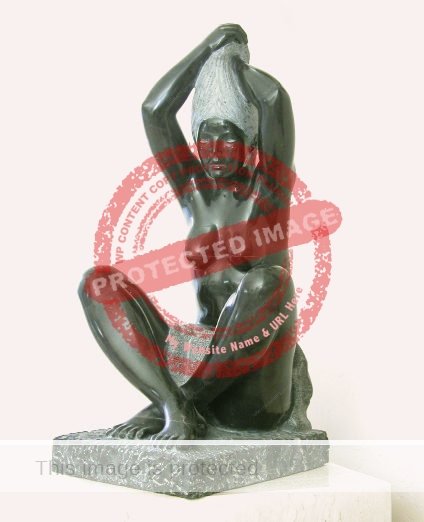Internationally renowned sculptor Felipe Castañeda was born on the shores of Lake Chapala. He was born on 16 December 1933 in La Palma (in the municipality then called San Pedro Caro, now Venustiano Carranza) at the south-east corner of Lake Chapala, where pre-Columbian artifacts are common. Castañeda’s lifetime in art shows the influence of millennia of sculptural techniques and creativity.

Felipe Castañeda. 1982. Untitled (Kneeling Woman).
Castañeda moved to Mexico City as a young man. In 1958, he entered La Esmeralda Painting and Sculpture Academy of the National Institute of Fine Arts in Mexico City where he took classes in drawing, modeling, carving and constructive drawing. He quickly became especially proficient at carving and sculpting.
In 1962, after he married his wife Martha, Castañeda began working for the National Museum of Anthropology in Mexico City. He also became assistant to the Costa Rican-born Mexican artist Francisco Zúñiga (1912-1998), a world renowned sculptor and the single greatest influence on Castañeda’s artistic career.
By 1966, Castañeda was already molding incredibly detailed plaster and clay sculptures when he turned his hand to working in stone. He now works mainly in marble, onyx and bronze. Many of his sculptures depict the female form, whether wife, mother, lover or friend. Castaneda’s harem of perfectly proportioned women are simultaneously both mysterious and provocative.
Castañeda held his first one-man show in 1970 at the Sala de Arte (Gobierno del Estado de Nuevo León) in Monterrey, México.

Felipe Castañeda. 1986. “Gracia”.
His major solo exhibitions include Galería Mer-Kup, Mexico City (1977); Mexican Art International, La joya, California (1978); Princes Hotel, Acapulco, Guerrero (1988); Hotel Pierre Marqués, Acapulco, Guerrero, (1980); Art Expo, New York (1983, 1984, 1985); Universidad Autónoma Metropolitana, Mexico City (1988); 30 Años Galería de Arte Misrachi, Mexico City (1990); Museo de Arte Contemporáneo, Morelia, Michoacán (1991); Club Britania, Morelia, Michoacán (1991); the B. Lewin Galleries, Palm Springs, California (1982, 1983, 1986, 1989, 1990, 1992, 1994); Le Kae Galleries, Scottsdale, Arizona (1995); Instituto Cultural Mexicano Israel-IbereoAmerica, Mexico (1996); Galeria Lourdes, Chumacero, Mexico (1997); Museo de la Isla de Cozumel, Mexico (1997); Mexican Cultural Institute, Los Angeles, California (1998); Whitney Gallery, Laguna Beach, California (1999); Alvarez Gallery, Laguna Beach, California (1999); “New Gallery Artist Exhibition,” Eleonore Austerer Gallery, San Francisco, California (1999); and the Anderson Art Gallery, Sunset Beach, California (2000).
Among Castañeda’s group exhibitions are numerous shows in Morelia (Michoacán), Zacatecas, San Salvador (El Salvador), San Francisco (California); and Palm Springs (California).
Castañeda, who has received awards for his work from UNICEF (1980), Israel (1996) and from the International Academy of Modern Art in Rome (1998), currently lives and works in Morelia, Michoacán. This 4-minute YouTube video (in Spanish) shows the artist at work in his studio:
Commissioned public sculptures by Castañeda can be seen in a number of Mexican cities, as well as in Palm Springs, California. Examples of his work are in the permanent collections of the Los Angeles County Museum of Art and the Museum of Art History in Ciudad Juárez, Mexico, among many others.
Sources:
- Felipe Castañeda (Gallery BIBA, Palm Beach, Florida)
- Felipe Castaneda (Artnet)
- Felipe Castaneda (Artistic Gallery) [http://www.artisticgallery.com/biographies/castanedabio.htm – 20 Nov 2017]
- Felipe Castañeda Jaramillo (Bio on his website “Estudio de la Calzada”) – http://www.espejel.com/estudiocalzada/bio.htm [20 Nov 2017]
Sombrero Books welcomes comments, corrections or additional material related to any of the writers and artists featured in our series of mini-bios. Please email us or use the comments feature at the bottom of individual posts.
Tony Burton’s books include “Lake Chapala: A Postcard History” (2022), “Foreign Footprints in Ajijic” (2022), “If Walls Could Talk: Chapala’s historic buildings and their former occupants” (2020), (available in translation as “Si Las Paredes Hablaran”), “Mexican Kaleidoscope” (2016), and “Lake Chapala Through the Ages” (2008).